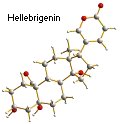Obesity is a major risk factor for colon cancer, but until now medical scientists were at a loss to explain why. Now, a study of on three human colon cancer cell-lines has demonstrated that the “fat hormone” leptin may enhance the growth of colonic cancer cells. The discovery not only offers an explanation as to the underlying cause of the increase colon cancer risk in obesity but could lead to a new approach to fighting this type of cancer.
The hormone leptin is released by fat cells, adipocytes, so the higher your body fat content (calculate your body fat now), the higher the concentration of leptin in your blood stream is likely to be. Leptin plays a key role in regulating metabolism, body weight and energy expenditure.
According to previous research, people who are obese are two to three times more likely to develop colon cancer than their leaner counterparts. Other research revealed that some colon cancer cells carry receptors for leptin.
Now, scientists at the University of California San Diego School of Medicine believe they have found the link.
“These results may explain why obesity increases a person’s risk of colonic cancer, and the fact that we have shown how leptin stimulates these cells means that drug companies may be in a better position to develop new treatments against the disease,’ says UCSD’s Kim Barrett.
The team grew cancer cells in the laboratory and found that leptin could stimulate their growth. In two out of three cell lines, leptin also blocked normal programmed cell death, apoptosis, which usually prevents runaway cell growth. When apoptosis fails normal cells can become cancerous.
The researchers explain that they have also found the complex chemical signalling pathways in the cell that are influenced by leptin, which reinforces their claim that leptin does indeed play a critical part in influencing cancer cell growth in the colon.
The results are published in detail in the journal BJS.
 Many people in the modern Western world delude themselves that their culture is generally free from the effects of intoxicating substances except in the criminal underworld, and that ‘nice people don’t take drugs’. But Richard Rudgley of the University of Oxford, a researcher of the oasis communities of Chinese Central Asia, shows that our culture and other cultures across the world have a rich tradition of using chemicals, mainly from plants, to produce altered states of consciousness. These range from the ritualistic use of the fly-agaric in Palaeolithic Europe to betel-nut chewing in Papua New Guinea, and from pretentious bone-china tea sets in Surbiton to the tragic inhaling of petrol fumes by Aboriginal Australians.
Many people in the modern Western world delude themselves that their culture is generally free from the effects of intoxicating substances except in the criminal underworld, and that ‘nice people don’t take drugs’. But Richard Rudgley of the University of Oxford, a researcher of the oasis communities of Chinese Central Asia, shows that our culture and other cultures across the world have a rich tradition of using chemicals, mainly from plants, to produce altered states of consciousness. These range from the ritualistic use of the fly-agaric in Palaeolithic Europe to betel-nut chewing in Papua New Guinea, and from pretentious bone-china tea sets in Surbiton to the tragic inhaling of petrol fumes by Aboriginal Australians.